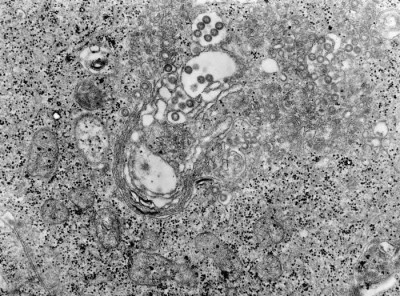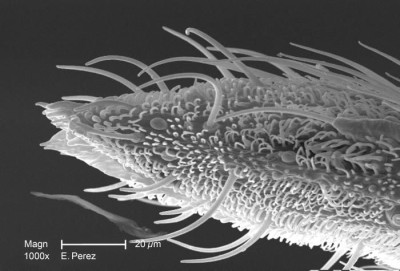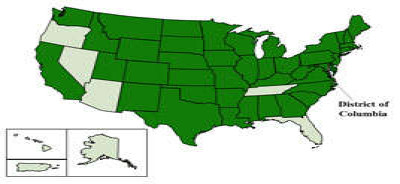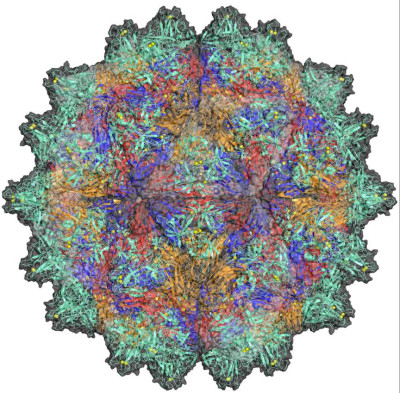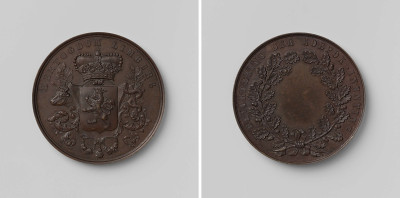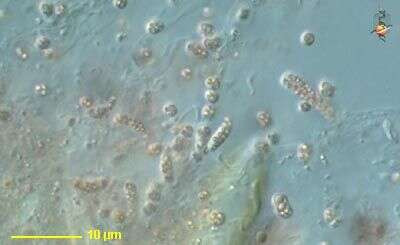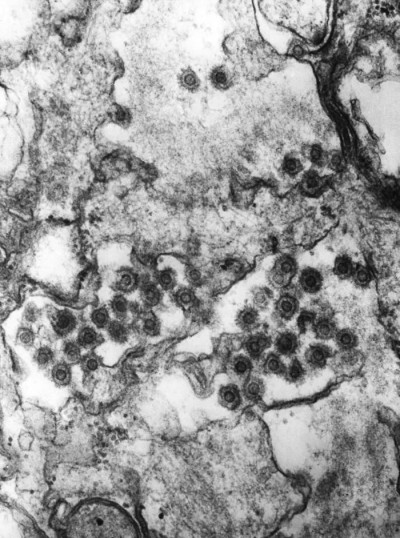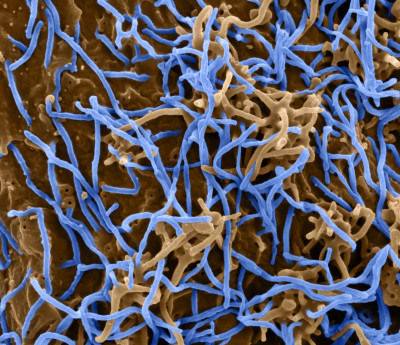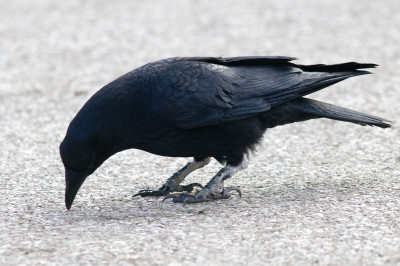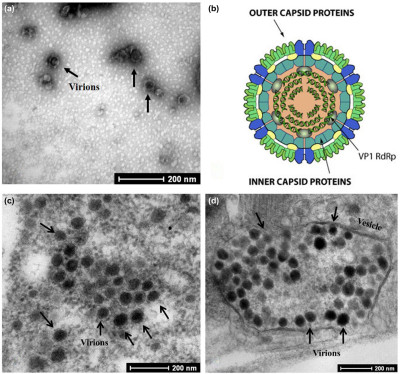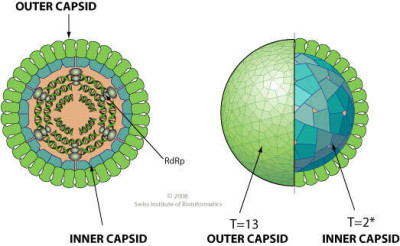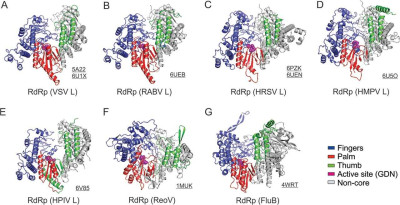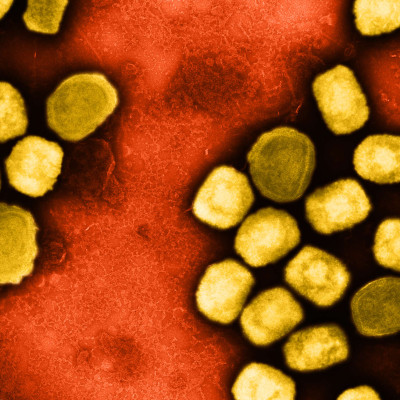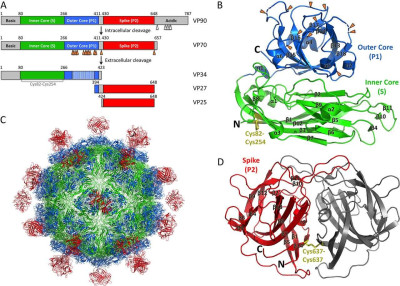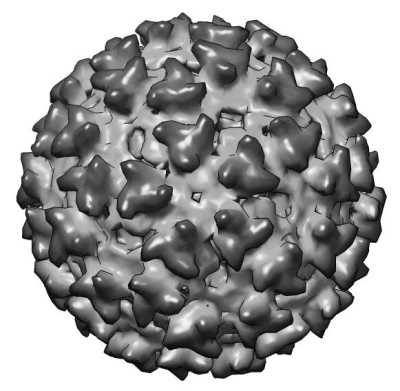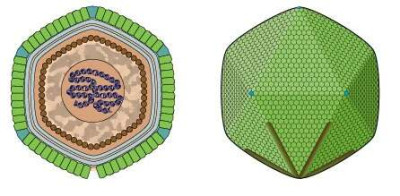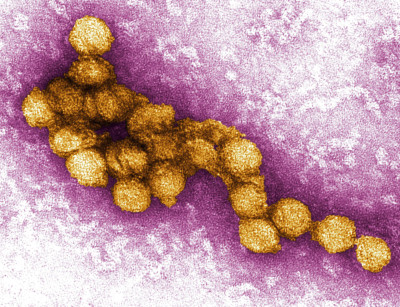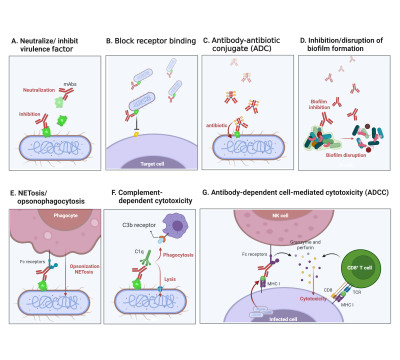This transmission electron micrograph (TEM) depicted a highly magnified view of a tissue that had been infected with Rift Valley fever (RVF) virus. RVF virus is a member of the genus Phlebovirus in the family Bunyaviridae and was first reported in livestock in Kenya around 1900. It is found to be an acute, fever-causing viral disease that affects domestic animals (such as cattle, buffalo, sheep, goats, and camels) and humans. RVF is most commonly associated with mosquito-borne epidemics during years of unusually heavy rainfall.
Public Health Image Library
11 Apr 2024
At a magnification of 1000X, this scanning electron micrograph (SEM) revealed some of the minute exoskeletal details found at the proboscis tip of an unidentified mosquito found deceased in the suburbs of Decatur, Georgia. The proboscis is the organ used by this, as well as other like insects, to feed upon the blood of a warm-blooded host, including human beings. What you see here, is the sheath that encases a pair of needle-sharp "stylets", which together are known as the "fascicle". The larger of the two stylets, known as the "labrum", when viewed in cross-section, takes on the shape of a "V", and acts as a gutter, which directs the ingested host blood towards the insect's mouth. The hair-like structures are known as "setae", and are really extensions of the insect's exoskeletal, chitinous covering. These setae act as sensory organs, transmitting impulses indicating changes in the organism's environment.
Public Health Image Library
11 Apr 2024
A map of states in the US with confirmed cases of Enterovirus D68.
Wikimedia Commons, CDC
16 Apr 2024
Description: English: Crystal structure of Grouper nervous virus (GNNV), a betanodavirus.
Wikimedia Commons, Chunjungchen
24 Apr 2024
Left: Crowned coat of arms, surrounded by decorative ornaments, flanked by a cow's head on the left and a club on the right, with a snake entwined around it; garlands of flowers beneath the coat of arms within the inscription. Right: Blank field within an oak wreath and inscription.
Wikimedia Commons, Rijksmuseum
31 May 2024
Under the microscope, the intricate details of blood within a needle are revealed. Tiny red blood cells, essential for oxygen transport, cluster together, their unique biconcave shape clearly visible. Amidst them, a few larger white blood cells stand out, guardians of the immune system, ready to fight off infections. Plasma, the liquid component, fills the spaces between these cells, carrying nutrients and waste products. This close-up view highlights the complexity and beauty of blood, showcasing its vital role in sustaining life and its critical importance in medical diagnostics and treatment.
04 Jul 2024
Chromatium and Thiocystis - red sulphur bacteria (or purple sulphur bacteria). They are found in sediments above the reduced zone. Both use solar energy to assist in the oxidation of hydrogen sulphide producing elemental sulphur which is deposited within the bacterial cell as sulphur granules. Photosynthetic pigments are pink which give the cells their colour. Chromatium are the larger spherical and elongate cells with larger sulphur granules, Thiocystis are smaller are not easy to distinguish from the detritus.
David Patterson, Linda Amaral Zettler and Virginia Edgcomb, micro*scope
23 Jul 2024
This negatively-stained transmission electron micrograph (TEM) revealed the presence of numerous double-stranded, full-length DNA-containing (dsDNA) spumavirus, or foamyvirus virions. One of the identifying morphologic characteristics displayed by these virions is the spikey nature of their protective proteinaceous capsid, which is a feature evident in this TEM.
Public Health Image Library
02 Apr 2024
Colorized scanning electron micrograph of Ebola virus particles (blue) found both as extracellular particles and budding particles from chronically infected African green monkey kidney cells (brown).
NIAID, Wikimedia Commons
24 Jan 2024
Carrion crow (Corvus corone) with infectious leg papillomatosis at the Parc des Buttes Chaumont in Paris.
Marie-Lan Nguyen / Wikimedia Commons
25 Jan 2024
(a) Transmission electron micrograph (TEM) of purified virus particles. (b) Conceptual diagram of rice black‐streaked dwarf virus particles (RBSDV) particle structure. (c) TEM of virus particles in insect midgut samples. (d) TEM of virion‐containing vesicles in insect midgut tissues [1].
Wikimedia Commons, Nan Wu, Lu Zhang, Yingdang Ren, and Xifeng Wang, ViralZone, SIB Swiss Institute of Bioinformatics
25 Jan 2024
Non enveloped, icosahedral virion with a double capsid structure, about 80 nm in diameter. The outer capsid has a T=13 icosahedral symmetry, the inner capsid a T=2* icosahedral symmetry.
ViralZone, Wikimedia Commons
25 Jan 2024
(A to E): The ribbon representations of the RdRp domain of the Rhabdoviridae (VSV and RABV), Pneumoviridae (HRSV and HMPV), and Paramyxoviridae (HPIV) L in conventional orientation. The structural motifs finger, palm, thumb, and support region are in blue, red, green, and gray, respectively. The tri-residues (GDN) of the RdRp active sites at a β-hairpin tip of the palm motif are shown in magenta spheres. (F and G): Similarities of the Mononegavirales RdRp domain to other viral polymerases. Structures of the polymerases of reovirus λ3 (ReoV; PDB: 1MUK) and influenza B (FluB; PDB: 4WRT) are shown as the same orientation and coloring scheme as in A. The PDB accession codes are underlined. [1]
Bo Liang / Wikimedia Commons
25 Jan 2024
Photograph of blueberry flowers with blueberry shoestring virus.
Mark Longstroth, Wikimedia Commons
31 Jan 2024
Colorized transmission electron micrograph of monkeypox virus particles (yellow) cultivated and purified from cell culture. Image captured at the NIAID Integrated Research Facility (IRF) in Fort Detrick, Maryland.
NIAID
31 Jan 2024
(A) Schematics of the HAstV-1 capsid protein (CP) domain structure and proteolytic processing events. Caspase and trypsin cleavage sites are indicated with white and orange arrows, respectively. (B and D) Crystal structures of the HAstV-1 CP core (B) and spike (D). Trypsin cleavage sites are indicated with orange arrows. Disulfide bonds are labeled and colored yellow. N and C termini are labeled. (C) Model of mature T=3 HAstV-1 virion. Figures were made with PyMOL [1].
Wikimedia Commons, Royce L. York, Payam A. Yousefi, Walter Bogdanoff, Sara Haile, Sarvind Tripathi, and Rebecca M. DuBois
01 Feb 2024
Cryo-electron microscopy of Sindbis-liposome complex.
Wikimedia Commons, A2-33
07 Feb 2024
Schematic drawing of a Rheavirus (aka Cafeteriavirus) virion (cross section and side view).
ViralZone, SIB Swiss Institute of Bioinformatics, Wikimedia Commons
08 Feb 2024
A micrograph of the West Nile Virus.
Cynthia Goldsmith, P.E. Rollin, USCDCP, Wikimedia Commons
08 Feb 2024
Multifaceted mechanisms of mAbs against bacterial figure illustrates the complex mechanisms through which mAbs counteract bacterial infections. (A) Highlights the neutralization or inhibition of bacterial virulence factors by mAbs, mitigating their pathogenic effects. (B) The process of mAbs blocking receptor-mediated adhesion is depicted, preventing bacterial adherence to host cells and hindering the progression of infection. (C) Portrays the Antibody–Antibiotic Conjugate (ADC) strategy, where mAbs conjugated with antibiotics enhance the precision and effectiveness of bacterial targeting and elimination. (D) Focuses on the role of mAbs in inhibiting or disrupting biofilm formation, a primary bacterial defense mechanism, facilitating bacterial clearance. (E) Illustrates the mAb-mediated NETosis/opsonophagocytosis pathway, promoting bacterial clearance through the facilitation of neutrophil extracellular traps (NETs) and enhanced phagocytosis. (F) Delineates the activation of complement-dependent cytotoxicity by mAbs, leading to bacterial cell lysis. (G) Illustrates the synergy between innate and adaptive immune responses facilitated by mAbs in Antibody-Dependent Cell-Mediated Cytotoxicity (ADCC), enhancing the clearance of bacterial infections. [1]
19 Feb 2024
 Encyclopedia
Encyclopedia
